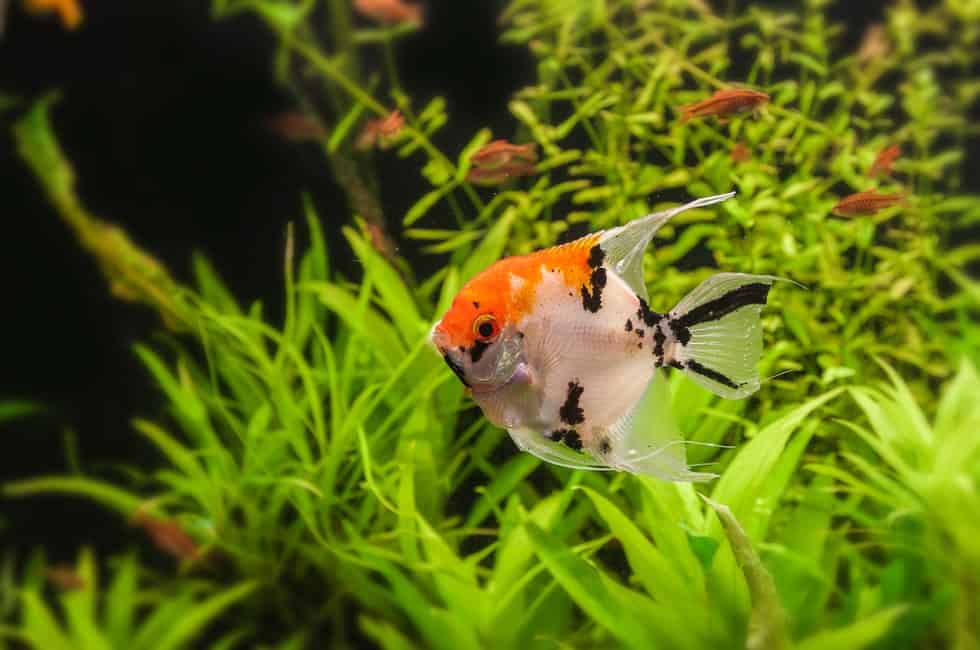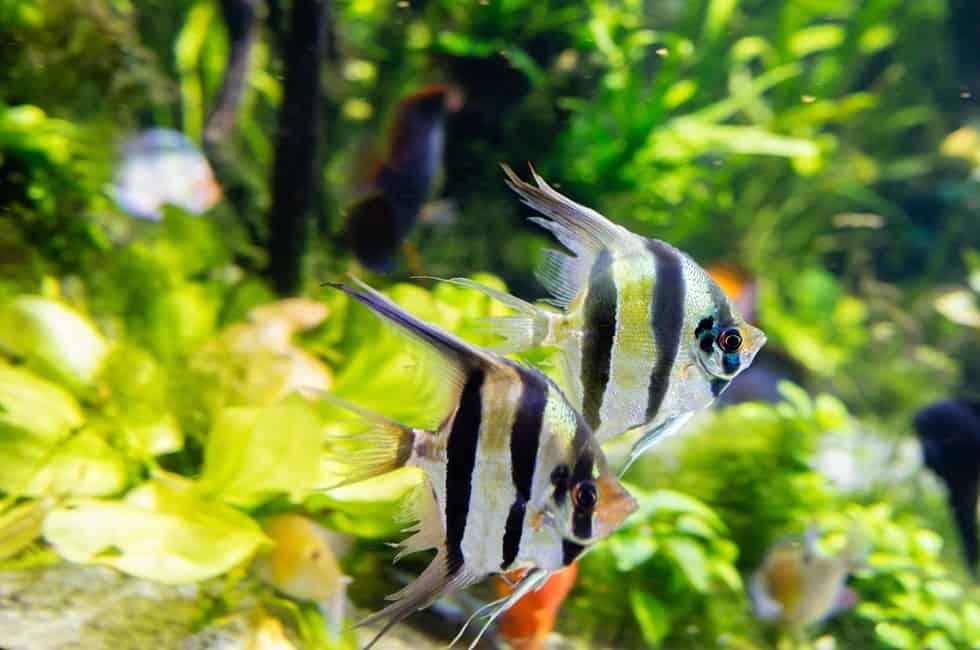It is important for you to know this to ensure that you are able to manage your fish tank very well. This article will surely provide more information on everything you need to know about Angelfish.
How big do Angelfish get? Angelfish is a small, freshwater fish that is native to the Amazon Basin. Depending on the species and habitat, Angelfish can grow between 2 to 12 inches in length.
How Big Do Angelfish Get in Fish Tank
Angelfish Can grow up to 6 inches in a little crowded tank and up to 10 inches in a bigger tank. Angelfish belongs to the South American Cichlid that is non-aggressive and prefers freshwater conditions.
The fish can grow in a very low acidic to very low alkaline water conditions of between 6 and 8pH.
You can help your Angelfish attain its maximum growth size when you meet it’s aquarium conditions. This means the tank must be kept clean always since the fish prefers fresh water. They also prefer moderately larger fish tanks. Having them in the right size tanks will also reduce stress on them.
Angelfish are Carnivorous in nature; hence they must be fed with the right diet to help them attain their maximum growth size. While flakes and some other formulated pelted diets are good for them, these fishes prefer the natural diets comprising of Bloodworms, shrimps, and Daphnia.
Angelfish are best raised in the tank with their own kinds. Though they are more of communal fishes when young but they become more territorially aggressive as they mature. For this reason, it will be better to raise them inside a separate tank. The tank temperature for this fish should not exceed 78F degrees
How Big Do Angelfish Get in the Wild
Angelfish perform much better in the wild where it can grow up to its maximum length of 12 inches with access to its natural food. Angelfish is susceptible to Ich in the wild especially when its natural habitat is suddenly polluted.
Ich is a parasitic infection that can spread from the fish to other fishes sharing a tank. Inch infestation is also linked to overcrowding, poor diet, and poor water conditions.
Most Angelfishes harvested from the wild will perform very well and grow quickly when fed with Carnivorous diets.
Different Types of Angelfish and Their Size
Angelfish are elegant and colorful additions to your aquarium. They are normally tall and thin, with long fins trailing behind them when they swim. They have been kept for centuries as pets all around the world.
There are several kinds of Angelfish, their sizes and names are summarized in the table below
| Angelfish | Size |
| Marble Angelfish | 6 inches at maturity |
| Veil Angelfish | 6 inches at maturity |
| Zebra Angelfish | 6-7 ½ inches at maturity |
| Ghost Angelfish | 6-8 inches at maturity |
| Black lace Angelfish | 8-10 inches at maturity |
| Leopard Angelfish | 6 inches at maturity |
| Gold Angelfish | 6 inches at maturity |
| Blushing Angelfish | 6-10 inches at maturity |
| Koi Angelfish | 6-8 inches at maturity |
| Smokey Angelfish | 6-7 inches at maturity |
| Altum Angelfish | 7-10 inches at maturity |
| Albino Angelfish | 6inches at maturity |
The Marble Angelfish is known for its marbled markings that are displayed all over its body. The marble markings may appear in different color variations, while the marbling is black. This is one of the most resilient Angelfish you should consider for your tank because it can withstand adverse conditions such as temperature fluctuations.
The Veil Angelfish has remarkable longer fins, these fins can make them vulnerable to a number of hazards, hence they should be kept in bigger tanks. Veils are not as resilient as the Marble Angelfish, hence excessive fluctuations in water temperature can affect them negatively.
The Zebra Angelfish derived its name from the vertical stripes on its body that looks like that of a Zebra. It also comes with a distinctive and delicate blue coloring.
Ghost Angelfish is distinctively recognized by its silver color which is shimmering. At maturity, it develops some partial stripping on the body. There are also variations in the Ghost Angelfish family.
The Albino Angelfish is another type of Angelfish that is easily recognized by its lack of color plus red eyes. The Albino Angelfish is quite beautiful despite not having bright colors like other Angelfishes. It can appear white or with some light golden stripes. The albinos are fragile and may develop some health issues. They do have shorter lifespans.
The Black lace Angelfish comes with predominantly black colored body hence it is very distinctive, even when it shares the aquarium with some other fishes.
Leopard Angelfish is mostly known for its spotted patterned body. These spots on the body may fade away under poor lighting conditions in the tank.
The Gold Angelfish is one of the most popular angelfishes in the market. Though it starts with a silver-gold at a tender age, the golden color becomes richer at adulthood.
The Blushing Angelfish resembles the Gold Angelfish, but with an orange or red coloring on its gills. The colored gills often look like some blushing cheeks.
The Koi Angelfish looks a lot like Koi Carp, except for its orange or white coloring.
The Smokey Angelfish comes with a grey coloring and comes in variations such as Smokey Leopard and Smokey Blushing.
The Altum Angelfish is not always available in pet stores, and the reason is that they are exclusive to the wild.
Ideal Tank Size for Angelfish
Though the ideal tank size for Angelfish can depend on the size of the fish, its growth pattern and how aggressive it is. In most cases, the 30-gallon tank size is recommended for single or a pair of Angelfish.
You will have to increase the tank size if you are raising a community of fish, which includes the Angelfish. In this case, a tank size of 50 gallons at least, is recommended.
Since most adult Angelfish will grow up to between 4 and 8 inches in length, a tall tank is normally recommended, in addition to 30 gallons in length.
If you plan to have any fish other than Angelfish in the tank, then you should consider a size bigger than 30 gallons because Most Southern American Cichlids can be gentle when growing and become semi-aggressive at maturity.
Angelfish will require lots of swimming spaces, despite being bottom swimmers, they should not be raised together with aggressive Cichlids such as African Cichlids when they are still growing.
A 30-gallon tank should be large enough for two angelfish alongside a couple of compatible non-aggressive fishes.
Since Angelfish are bottom swimmer that prefer swimming a lot, it is important to include rocks and hiding decorations in the tank, to support their activities.
Though Angelfish prefer freshwater conditions, the pH of the water should be between 6 and 8. The water temperatures should not be higher than 85F degrees.
Angelfish are not particularly strong swimmers; fast water in your tank may create stressful conditions. Fast water movements also mean that Angelfish will use up more energy and that could negatively affect its growth and development.
You may want to add some under-gravel and sponge filters that will generate some gentle currents that will allow the Angelfish to conserve more energy.
The Angelfish tank should not be placed directly in line with the scorching heat of the sun, placing the tank directly in contact with the sun can warm up the water quickly which is not good for Angelfish.
If you are setting up a tank containing more than one Angelfish, you should consider placing a tall plant in the center.
Other Things You Should Know About Angelfish
Unlike many other species of orchids, the male and female Angelfish look the same. These fish species can be considered as rewarding species to hobbyists because they are not as difficult to raise in a tank like many other Cichlids, even though they possess their own challenges.
Make Angelfish tank water clean and feed them carnivorous diet more often than pellets and you will be able to raise them from Juveniles to full-grown adults.
Angelfish are predominantly shy and prefer to hide in densely populated areas, in the wild, hence you should try and replicate this environment in the tank.
Angelfish are very sexually active and they reproduce at faster rates than many other Cichlids. You may want to remove the fries frequently to prevent the over-population of Angelfish in your tank.
Conclusion
One of the most important factor when raising Angelfish is that you must choose a tank companion with care. Fin-nippers and other aggressive fishes can damage the long beautiful fins of the Angelfish.
On the other hand, Angelfish will eat smaller fishes such as Neon Tetras. Fast-moving fish species will be quicker to eat most of the food than the slow-swimming Angelfish and they can also get the Angelfish nervous with their quick-moving skills.
Angelfishes will perform very well with Gouramis and non-aggressive Cichlids of similar sizes. It is important to choose tank mates that can grow bigger than Angelfish and not aggressive.




Stanley Roberson
Tuesday 23rd of June 2020
Thank.you.i am.fish lover to.i "ve. Angie fish....I don't know if male.female.